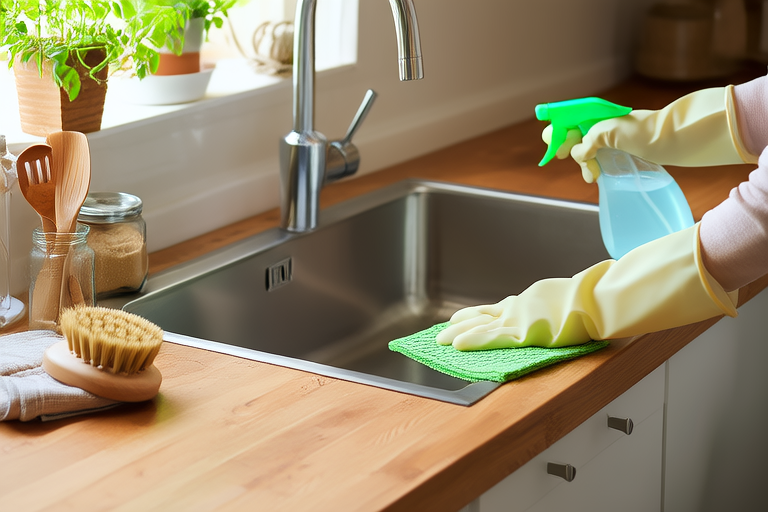Introduction
In today’s world, environmental consciousness is more important than ever. As we strive to reduce our carbon footprint and protect the planet, making simple changes in our daily routines can have a significant impact. One area where many households can make a difference is in cleaning products and methods. Traditional cleaning products often contain harsh chemicals that are harmful to both the environment and human health. By adopting eco-friendly cleaning hacks, you can maintain a clean home while minimizing your ecological footprint. This article will guide you through various green cleaning tips, from DIY solutions to sustainable practices, ensuring your household remains clean and environmentally friendly.
The Benefits of Eco-Friendly Cleaning Products
Reduced Environmental Impact
Using eco-friendly cleaning products helps reduce pollution by minimizing the release of harmful chemicals into the air, water, and soil. Many conventional cleaners contain volatile organic compounds (VOCs), which contribute to smog formation and can negatively affect air quality. Opting for natural alternatives not only benefits the environment but also improves indoor air quality, creating a healthier living space for you and your family.
Cost Savings
Eco-friendly cleaning often involves using common household items like vinegar, baking soda, and lemon juice. These ingredients are not only effective at removing dirt and grime but are also much cheaper than commercial products. Additionally, switching to refillable containers or concentrated formulas reduces waste and further cuts down on expenses. Over time, these small changes can lead to substantial savings.
Healthier Living Spaces
Traditional cleaning agents may contain allergens, irritants, and even carcinogens. Prolonged exposure to these substances can cause respiratory issues, skin irritation, and other health problems. By choosing non-toxic, biodegradable products, you create a safer environment for everyone in your home, especially children and pets.
DIY Eco-Friendly Cleaning Solutions
All-Purpose Cleaner
One of the simplest and most versatile eco-friendly cleaning solutions is an all-purpose cleaner made from white vinegar, water, and essential oils. To prepare this mixture:
- Mix 1 part white vinegar with 1 part water in a spray bottle.
- Add 10-15 drops of your favorite essential oil for fragrance (e.g., lavender, lemon, or tea tree).
- Shake well before each use.
This solution works wonders on countertops, floors, and bathroom fixtures. It effectively removes stains, grease, and bacteria without leaving behind any toxic residue.
Glass Cleaner
For streak-free windows and mirrors, try this DIY glass cleaner:
- Combine 1 cup of water with 1/4 cup of rubbing alcohol.
- Add 1 tablespoon of white vinegar.
- Stir in 1 teaspoon of liquid dish soap.
- Pour the mixture into a spray bottle and shake gently.
Spray onto surfaces and wipe clean with a microfiber cloth. This method leaves your glass sparkling while being kinder to the planet.
Wood Polish
To keep wooden furniture looking its best, use a mixture of olive oil and lemon juice:
- Mix 1 tablespoon of olive oil with 1 tablespoon of fresh lemon juice.
- Apply the polish to a soft cloth and rub it into the wood.
- Buff the surface with another clean cloth for a beautiful shine.
This natural alternative avoids the harsh chemicals found in many commercial polishes and nourishes the wood, extending its lifespan.
Sustainable Cleaning Practices
Microfiber Cloths
Switching to reusable microfiber cloths instead of disposable paper towels significantly reduces waste. Microfiber cloths are highly absorbent and effective at trapping dust and dirt, making them ideal for cleaning a variety of surfaces. They can be washed and reused multiple times, saving money and resources over the long term.
Cold Water Washing
Whenever possible, use cold water when washing clothes. Hot water consumes more energy and can actually set stains rather than remove them. Cold water is just as effective for most laundry tasks and helps preserve the color and texture of fabrics.
Green Laundry Detergent
Choose laundry detergents that are plant-based and free from artificial fragrances, dyes, and phosphates. Look for certifications such as USDA Organic or EcoLogo to ensure the product meets high environmental standards. These detergents are gentle on clothes and kinder to aquatic ecosystems.
Real-Life Examples and Practical Tips
Case Study: A Family’s Transition to Green Cleaning
The Johnson family decided to transition to eco-friendly cleaning after learning about the harmful effects of traditional products. They started by replacing their chemical-laden bathroom cleaner with a vinegar and essential oil mixture. Within a month, they noticed a significant improvement in indoor air quality and a reduction in respiratory symptoms among family members. They also began using microfiber cloths for daily cleaning, cutting down on paper towel usage by 75%. Their monthly cleaning expenses dropped by $30, and they felt better knowing they were contributing to a healthier planet.
Action Steps for Implementing Eco-Friendly Cleaning
- Evaluate current products: Take stock of the cleaning supplies you currently use and identify areas where you can switch to greener alternatives.
- Start small: Begin with one or two DIY recipes and gradually incorporate more sustainable practices into your routine.
- Invest in reusable tools: Purchase microfiber cloths, refillable bottles, and other reusable cleaning aids to minimize waste.
- Educate yourself: Stay informed about new eco-friendly products and techniques by following blogs, subscribing to newsletters, and joining online communities focused on green living.
Conclusion
Adopting eco-friendly cleaning habits is a straightforward yet impactful way to contribute to a healthier planet. By using natural ingredients, sustainable practices, and thoughtful choices, you can maintain a clean home without compromising the environment. Remember, every small change adds up, so start today by incorporating one or two of these tips into your daily routine. Not only will you enjoy a cleaner living space, but you’ll also feel good knowing you’re doing your part to protect the Earth for future generations.
